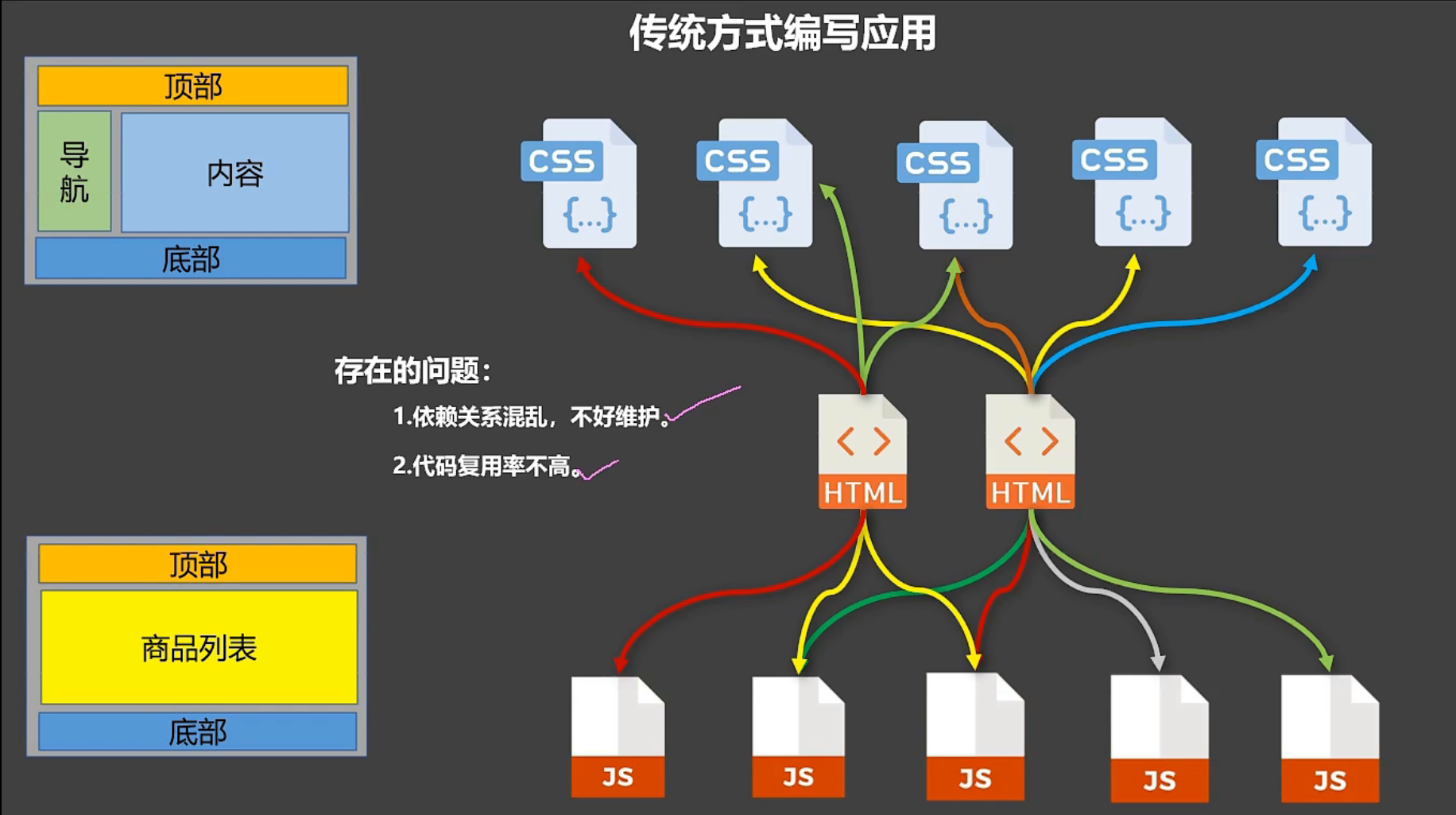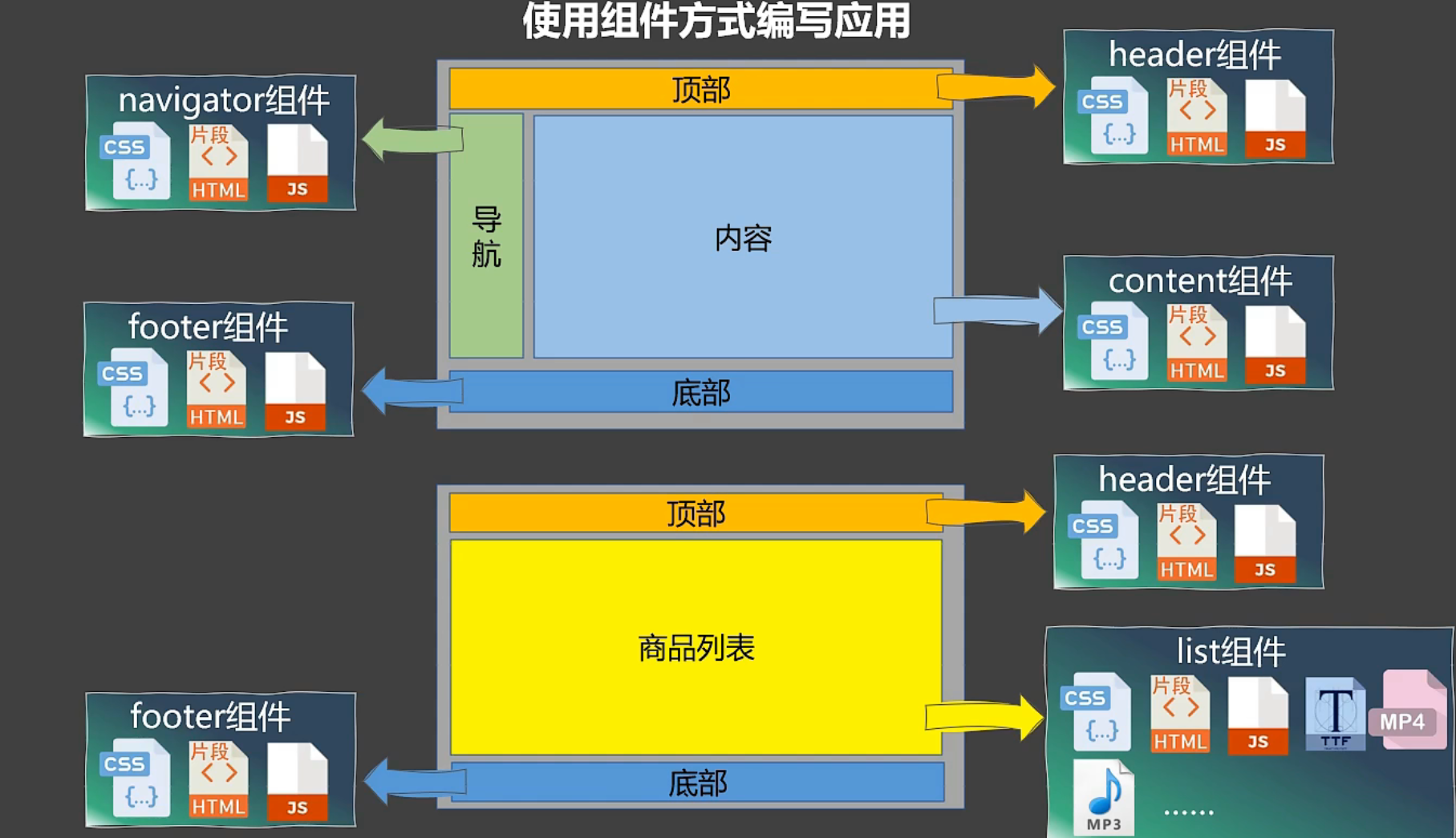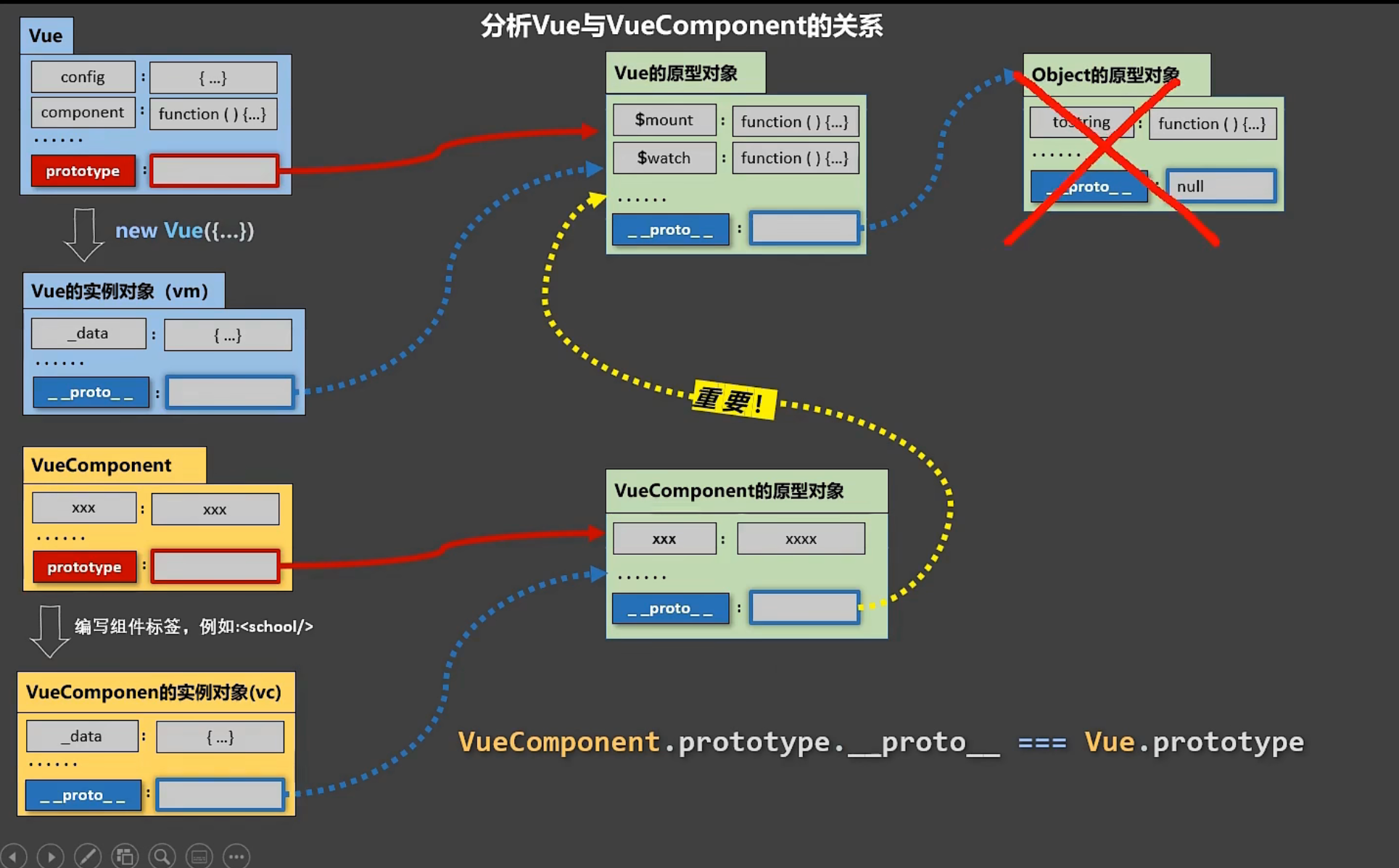- A+
所属分类:Web前端
组件化编程
什么是组件化编程
传统方式的编写模式

组件化编程的模式

组件是实现应用中局部功能代码和资源的集合
vue中非单文件组件的基本使用
点击查看代码
<!-- Vue中使用组件的三大步骤: 一、定义组件(创建组件) 二、注册组件 三、使用组件(写组件标签) 一、如何定义一个组件? 使用Vue.extend(options)创建,其中options和new Vue(options)时传入的那个options几乎一样,但也有点区别; 区别如下: 1.el不要写,为什么? ——— 最终所有的组件都要经过一个vm的管理,由vm中的el决定服务哪个容器。 2.data必须写成函数,为什么? ———— 避免组件被复用时,数据存在引用关系。 备注:使用template可以配置组件结构。 二、如何注册组件? 1.局部注册:靠new Vue的时候传入components选项 2.全局注册:靠Vue.component('组件名',组件) 三、编写组件标签: <school></school> --> <!-- 准备好一个容器--> <div id="root"> <hello></hello> <hr> <h1>{{msg}}</h1> <hr> <!-- 第三步:编写组件标签 --> <school></school> <hr> <!-- 第三步:编写组件标签 --> <student></student> </div> <div id="root2"> <hello></hello> </div> </body> <script type="text/javascript"> Vue.config.productionTip = false //第一步:创建school组件 const school = Vue.extend({ template:` <div class="demo"> <h2>学校名称:{{schoolName}}</h2> <h2>学校地址:{{address}}</h2> <button @click="showName">点我提示学校名</button> </div> `, // el:'#root', //组件定义时,一定不要写el配置项,因为最终所有的组件都要被一个vm管理,由vm决定服务于哪个容器。 data(){ return { schoolName:'尚硅谷', address:'北京昌平' } }, methods: { showName(){ alert(this.schoolName) } }, }) //第一步:创建student组件 const student = Vue.extend({ template:` <div> <h2>学生姓名:{{studentName}}</h2> <h2>学生年龄:{{age}}</h2> </div> `, data(){ return { studentName:'张三', age:18 } } }) //第一步:创建hello组件 const hello = Vue.extend({ template:` <div> <h2>你好啊!{{name}}</h2> </div> `, data(){ return { name:'Tom' } } }) //第二步:全局注册组件 Vue.component('hello',hello) //创建vm new Vue({ el:'#root', data:{ msg:'你好啊!' }, //第二步:注册组件(局部注册) components:{ school, student } }) new Vue({ el:'#root2', }) </script> 几个注意点
<!-- 几个注意点: 1.关于组件名: 一个单词组成: 第一种写法(首字母小写):school 第二种写法(首字母大写):School 多个单词组成: 第一种写法(kebab-case命名):my-school 第二种写法(CamelCase命名):MySchool (需要Vue脚手架支持) 备注: (1).组件名尽可能回避HTML中已有的元素名称,例如:h2、H2都不行。 (2).可以使用name配置项指定组件在开发者工具中呈现的名字。 2.关于组件标签: 第一种写法:<school></school> 第二种写法:<school/> 备注:不用使用脚手架时,<school/>会导致后续组件不能渲染。 3.一个简写方式: const school = Vue.extend(options) 可简写为:const school = options --> <!-- 准备好一个容器--> <div id="root"> <h1>{{msg}}</h1> <school></school> </div> </body> <script type="text/javascript"> Vue.config.productionTip = false //定义组件 const s = Vue.extend({ name:'atguigu', template:` <div> <h2>学校名称:{{name}}</h2> <h2>学校地址:{{address}}</h2> </div> `, data(){ return { name:'尚硅谷', address:'北京' } } }) new Vue({ el:'#root', data:{ msg:'欢迎学习Vue!' }, components:{ school:s } }) </script> 组件的嵌套(父组件、子组件和app组件)
<body> <!-- 准备好一个容器--> <div id="root"> </div> </body> <script type="text/javascript"> Vue.config.productionTip = false //阻止 vue 在启动时生成生产提示。 //定义student组件 const student = Vue.extend({ name:'student', template:` <div> <h2>学生姓名:{{name}}</h2> <h2>学生年龄:{{age}}</h2> </div> `, data(){ return { name:'尚硅谷', age:18 } } }) //定义school组件 const school = Vue.extend({ name:'school', template:` <div> <h2>学校名称:{{name}}</h2> <h2>学校地址:{{address}}</h2> <student></student> </div> `, data(){ return { name:'尚硅谷', address:'北京' } }, //注册组件(局部) components:{ student } }) //定义hello组件 const hello = Vue.extend({ template:`<h1>{{msg}}</h1>`, data(){ return { msg:'欢迎来到尚硅谷学习!' } } }) //定义app组件 const app = Vue.extend({ template:` <div> <hello></hello> <school></school> </div> `, components:{ school, hello } }) //创建vm new Vue({ template:'<app></app>', el:'#root', //注册组件(局部) components:{app} }) </script> VueComponent构造函数
<!-- 关于VueComponent: 1.school组件本质是一个名为VueComponent的构造函数,且不是程序员定义的,是Vue.extend生成的。 2.我们只需要写<school/>或<school></school>,Vue解析时会帮我们创建school组件的实例对象, 即Vue帮我们执行的:new VueComponent(options)。 3.特别注意:每次调用Vue.extend,返回的都是一个全新的VueComponent!!!! 4.关于this指向: (1).组件配置中: data函数、methods中的函数、watch中的函数、computed中的函数 它们的this均是【VueComponent实例对象】。 (2).new Vue(options)配置中: data函数、methods中的函数、watch中的函数、computed中的函数 它们的this均是【Vue实例对象】。 5.VueComponent的实例对象,以后简称vc(也可称之为:组件实例对象)。 Vue的实例对象,以后简称vm。 --> 分析vue和vuecomponent的关系

<!-- 1.一个重要的内置关系:VueComponent.prototype.__proto__ === Vue.prototype 2.为什么要有这个关系:让组件实例对象(vc)可以访问到 Vue原型上的属性、方法。 --> 



